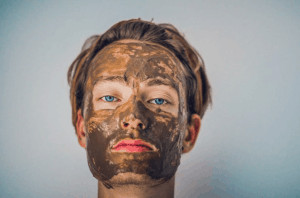Seaweed Health Benefits Explained: Skin, Hair And More

Seaweed is one of the oldest forms of vegetation in the world, with an approximated age of 3 billion years. Makes sense, really, seeing as how the ocean is where all life is said to have originated. These sea plants were made by Mama Ocean herself, and they’re chock full of vitamins, minerals, acids, and antioxidants.
To some, seaweed is the slimy goop that sticks to you when you wade into the waters of the sea. To others, it’s the stuff that goes around your sushi or in your soup. For those looking to exfoliate, moisturize, and rejuvenate their skin and hair, however, seaweed holds a very different interpretation, in the form of seaweed masks, wraps, shakes, and more.
Most people who are taking a stroll down the beach wouldn’t give this black-green stuff a double take. It’s just another green thing floating near and in the ocean. It really doesn’t seem like much, at a glance. An ordinary weed. But in fact, it’s not so ordinary. What exactly is seaweed?
What Is Seaweed?

Seaweed.
Because it’s very old, and because it has been around since the early days of planet Earth when the world was young, seaweed has had the benefit of soaking up many minerals and nutrients from the ocean’s floor. It’s what it is, really – a plant full of goodness, coming at you from way back when.
Seaweed’s health properties have been known for thousands of years. The oil found in the extract of different types of seaweed has been credited with having a detoxifying effect on the body, and with helping the rejuvenation of damaged skin tissue.
Whether used as a food, a remedy, or a nourishing cosmetic product – seaweed has it all, inside that inconspicuous little package. You can eat it in its dried or powdered form, or decide to ingest it as a food supplement.
Its antioxidants help fight agents of disease and stave off premature aging in our body. You can reap its benefits by using it as a wrap, wearing it as a facial mask, soaking with it in a hot bath, or eating it along with your favorite sushi, dishes, or soups. Nothing can stop the flow of time, but no one says you need to simply let it have its way with you.
There are many species of weeds in this planet’s seas and oceans, and all of them are potentially healthy for you (providing you don’t use it past the recommended dosage, of course). Some plants are more known than others; some are higher in their mineral count than others; and there are even some species of seaweed which are home to every known mineral which exists on the face of the earth! Talk about packing a punch.
How Can Seaweed Be Used For Beauty?

Clean beauty.
Baths and wraps of seaweed are considered classic spa treatments. The weeds of the sea contain anti-inflammatory agents that can help keep acne and other skin conditions at bay. The high content of iodine which seaweed boasts can aid in balancing the function of the thyroid gland, which is tasked with regulating various hormones in the body.
The thyroid also plays an important role in the body’s metabolism process, and some doctors may suggest seaweed as an alternative to prescription drugs. Thyroid gland imbalances could cause weight gain and depression, as well as insomnia, and it has been reported that about one adult in twenty will suffer from such an issue, so it is worth keeping an eye on.
Many products incorporate different types of algae into their formula, but not all of them have the same effect. The colors make a difference, as does the food or inactive/active ingredients which are grouped with it. Companies put seaweed in shampoos and conditioners, and even in dry shampoo and styling sprays.
You can use seaweed as a standalone item, or you can incorporate it into many routines for your hair, face, skin, and more. It promotes collagen production, helps make the skin brighter, and as previously mentioned, it has been used by ancient cultures throughout human history.
Seaweed Benefits For Hair Explained

Woman with healthy hair.
Hair is essentially strands of protein (or to be more specific, keratin). The strand itself is technically dead, since it is not receiving any nutrition. What is still receiving nutrition is the hair follicle, also known as the root. The hair grows from there and keeps growing from that point, which is why the road to a healthy head of hair often begins and ends with taking good care of the roots. The fatty acids which are present in seaweed can help the scalp transfer more nutrients to the hair follicles. These acids also help to improve circulation to the scalp. An increase in blood flow results in an increase in growth and protection.
No plant will come with a 100% guarantee, but seaweed is one of those which comes close. We all have different types of hair, different genetic makeups, and different hair care routines. Because of that, there are no absolutes when using seaweed, or when using any other hair care product, for that matter. Having stronger, thicker, healthier hair is something many of us desire. Not all of us will get our wish, unfortunately, but seaweed can help to tip the scales of hair-judgement in your favor.
Seaweed Benefits For Skin Explained

Woman with clear skin.
Seaweed is used as an exfoliator and detoxifier for the skin. The word “detox” gets thrown around a lot, so just to be clear – I mean to say that our skin harbors impurities, toxic elements, pollutants, and no small amount of dead skin. That’s what skin gets for being the physical barrier between the inner body and the outside world.
When we use seaweed, we help those toxic and undesirable elements wash or fall away, and this often helps the skin regain its smooth, flexible, and healthy self when it regenerates. The negative elements are either washed off in the shower, or they shed throughout the day. Dead skin and potentially harmful elements are being shed by us all the time. Seaweed can help the new skin to arrive in a smoother, more vital, and youthful-looking package.
Does this mean you are going to develop pinchable cheeks like those of a 3-year-old? No, not quite. But you will have the ability to look at yourself and see the difference after some time. Seaweed forms a kind of film which helps keep moisture in.
DIY Seaweed Skin Mask Recipe And Guide

Woman with seaweed face mask.
The seaweed naturally come in green, red, or brown. Each hue has its own attributes and advantages. Though in general brown is the one with the most benefits for human beings.
There are different ways to get the seaweed on your skin. The most popular approach is to use a wrap or skin mask. Don’t confuse this with a face mask, which has different sorts of benefits for the extra oily zones which are on our face. There are many sebaceous glands there, and some areas can become exceedingly greasy. Sebaceous glands secrete sebum, our body’s natural oil.
Our sebum takes good care of our face, and it helps keep it young-looking and healthy – but there is such a thing as having too much of it. For different reasons, sebum may accumulate and cause a buildup, and when that happens there are several possible outcomes. There are people who experience nothing, while others break out in redheads, blackheads, whiteheads, and other delightful symptoms.
This is why you should take caution and probably try something out on your own, at a lower level, before you go all out and purchase something large and extravagant. It’s best to know how your body reacts to seaweed. Do you enjoy eating it? Do you take pleasure in using it more as a mask? Or would you rather use it strictly as a body wrap? You’ll have to find at least some of the answers to these questions. Even though seaweed is very healthy, it is not everyone’s cup of tea.
Nothing can stop you from aging, but there are a few substances which can slow down the process. I am not talking about external processes and botox injections. I am talking about the antioxidant and anti-inflammatory properties of seaweed, for example. The effects can differ depending on your lifestyle and habits, your allergies and medical history, and also your diet.
This is meant to be a guide, but the word “guide” might be a bit of an overstatement. You have your past and your knowledge to guide you. The rule of thumb is: less is more. Don’t over-saturate your system with these ingredients or substances, or you run the risk of having a surplus and losing out on some of the benefits. Not only that, but you could cause potential harm if you overload your skin or hair with seaweed. I think the easiest DIY recipe for a seaweed mask is this one.
Ingredients
- Dried seaweed
- Honey or Greek yogurt or both
Method
Break the seaweed into small pieces, and then grind into powder. Place yogurt (3-4 tablespoons) into a small dish. Add the powder (1 teaspoon) and stir until the consistency is uniform. It’s optional to dd honey (1 teaspoon) and stir again. Apply the mask to a face which is clean and dry. Leave on for 10-15 minutes (better to start with less time). Remove the mask using warm water and/or a warm towel. Remove any residue using an appropriate toner
Side Effects Of Seaweed Explained
As mentioned, seaweed (or at least come species of weeds) is notoriously high in iodine. While there aren’t many people who exhibit sensitivity to large amounts of iodine, it’s a substance which can affect the thyroid gland – and that’s something which people are sensitive to. Issues with the thyroid gland can cause your body to overproduce or under-produce certain hormones, and if there are disruptions in that area the system may be thrown completely off balance.
Part of the wonder of this marine weed is how it absorbs different substances from the sea. Because it takes in so much from its surroundings, there is the danger of consuming too many heavy metals and minerals.
Vitamin K is another issue of the side effects of seaweed, since it could lead to problems with those who are taking medication for blood thinning. Make sure to be aware of the contraindications for usage of seaweed. If you have any doubts, ask your physician.
Conclusion
Like everything else in our lives seaweed is an ingredient which requires moderation and sound judgement. Remember, even cyanide is natural and organic. Don’t make the assumption that just because seaweed is a substance billions of years old, that it automatically is awesome and can do no wrong.
There are many kinds of weeds out there. It’s possible you’ll have to experience different ones before you settle on one which you react best with, depending on your condition or desired outcome. As Sebastian the Crab famously sang in Disney’s The Little Mermaid, “the seaweed is always greener in somebody else’s lake!”
Seaweed is not some miracle substance. Marketers may call it that, but it doesn’t work miracles of any kind. It’s a natural substance which holds great potential for those who know how to use it. Whether you work it into your hair and scalp, apply it topically to your face and skin, or ingest it through your food or beverages – it’s a plant that can make a difference.


